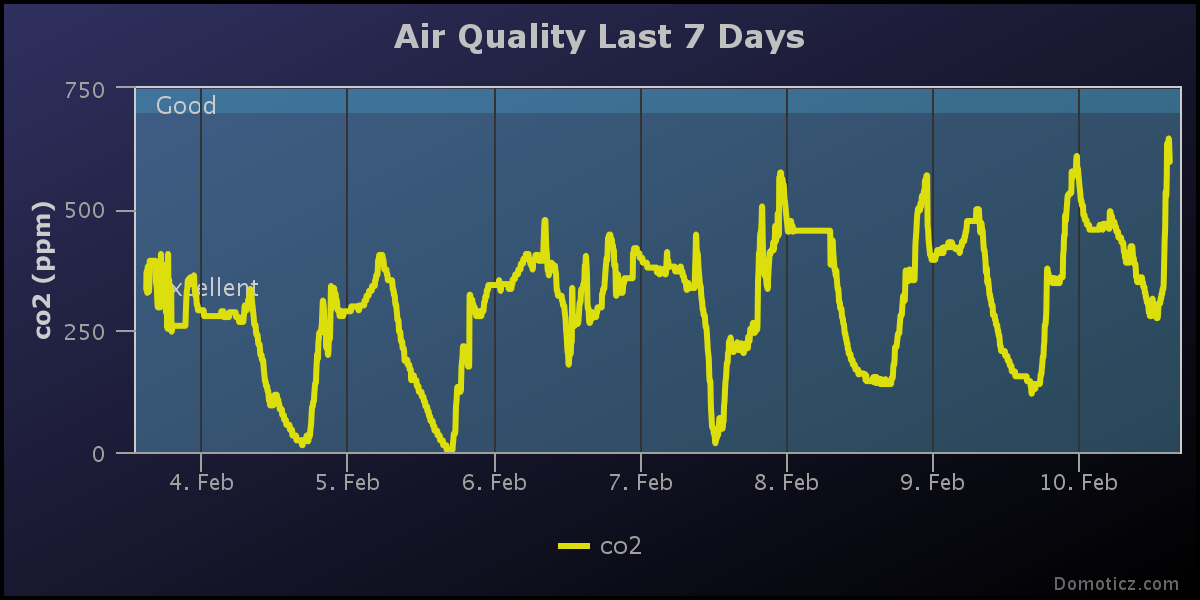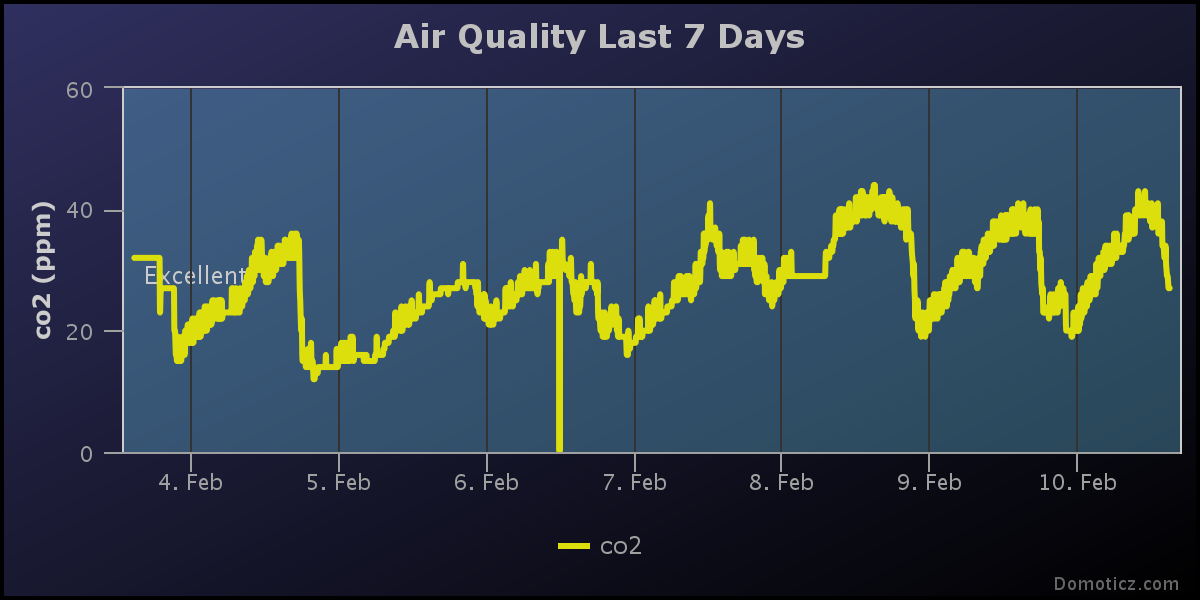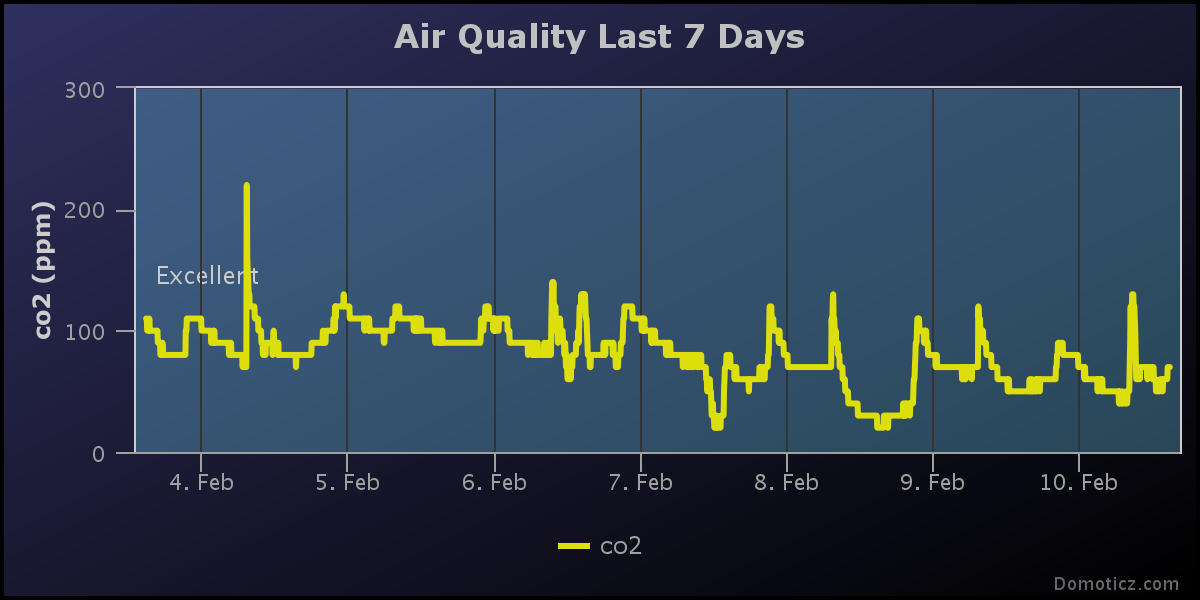Air Quality Sensor
-
Hello
In MiCS 2614 or in any gas sensor. what should be the value of R0... Because in datasheet they mentioned that value is measured in ambient condition. Any default value for that??
@bhavika said:
Hello
In MiCS 2614 or in any gas sensor. what should be the value of R0... Because in datasheet they mentioned that value is measured in ambient condition. Any default value for that??
The datasheed propose the "clean air calibration": "Sensing resistance in air R0 is measured under controlled ambient conditions, i.e. synthetic air at 23 ±5°C and 50 ± 10% RH. Sampling test."
so you should go outside and mesure the defautl R0 value in your environment. -
MQ-135 with 10k results in a R0 of around 360 in my environment. So you could start experimenting with values around 300-500. I had to use a voltage regulator to get reliable values from the sensor.
-
a little update on the MICS-6814:
NO2: sensible
CO: flat
NH3 flat

For the HCHO:

sorry for the flat part, some arduino issues at this time
-
I have had some questions about converting from mg/m3 to ppm gases, here are the weight values and a proposed method:
NH3 17.03 g/mol
CO2 44.01
CO 28.01
H2S 34.08
NO2 46.01
NO 30.01
O3 48.00
C6H6 78.11
C7H8 92.14you have:
NO2 50 μg/m3 gives 26,5868821 ppm
O3 27 μg/m3 = 0.027 mg/m3 -> (8,31441298,15)/(48101,325)*27=13,7617025 ppmcorrect me if I'm wrong
-
2016 is where IoT for gas sensors are moving to more maturity, Cooking Hacks / Libellium proposed so far Fibaro sensors, but are now proposing more pricey one that are calibrated.
-
CO2 with MH-Z14

NO2 MICS-6814

HCHO sensor

-
In MQ135 sensor's datasheet , which line on the curve is used to find out the concentration of benzene?
@bhavika said:
In MQ135 sensor's datasheet , which line on the curve is used to find out the concentration of benzene?
MQ135 is sensitive to particle size, benzene is one of these. I rememer someone who used the chinese datasheet and found a chinese to translate it.
-
@epierre I am testing a stripped-down version of your code from your AirQuality-MQ135.ino. I stripped it to make it run just stand-alone.
What I don't understand is how to do the calibration. When I run it in outside environment (with 10k resistor), I get these values:valr 223 Vrl / Rs / ratio:13387 / 20875.00 / 0.00What would be the next step for calibration?
-
@epierre I am testing a stripped-down version of your code from your AirQuality-MQ135.ino. I stripped it to make it run just stand-alone.
What I don't understand is how to do the calibration. When I run it in outside environment (with 10k resistor), I get these values:valr 223 Vrl / Rs / ratio:13387 / 20875.00 / 0.00What would be the next step for calibration?
@supersjimmie replace MQ135_DEFAULTRO by your value 20875 in the sketch
-
@supersjimmie replace MQ135_DEFAULTRO by your value 20875 in the sketch
@epierre Thanks, I thought it would be something like that, but that didn't work.
I then gotvalr 242 Vrl / Rs / ratio:5464 / 8520.00 / 0.00Nothing like around 400ppm.
-
yes for the code must be updated, the value is the CO2 (or something else) detected above the 399 in atmosphere
gw.send(msg.set(MQ135_DEFAULTPPM+(int)ceil(valAIQ))); -
Thanks, but when calibrating something strange happens when I put the module outside:
valr 270 Vrl / Rs / ratio / ppm 61355 / 95673.00 / 0.00 / 399.00 valr 265 Vrl / Rs / ratio / ppm 62928 / 98126.00 / 0.00 / 399.00 valr 260 Vrl / Rs / ratio / ppm 64561 / 100673.00 / 0.00 / 399.00 valr 256 Vrl / Rs / ratio / ppm 378 / 589.00 / 0.00 / 399.00 valr 252 Vrl / Rs / ratio / ppm 1773 / 2764.00 / 0.00 / 399.00As you can see, the valr decreases slowly, but suddenly Vlr and Rs jump over.
Vlr is the value of 'val', which is: uint16_t val = ((float)22000*(1023-valr)/valr);
uint16_t is 16bit, so max 65535. It looks like my environment needs more than that?
(in fact, your code defines the defaultro as 68550, which is also too much for a uint16?) -
Thanks, but when calibrating something strange happens when I put the module outside:
valr 270 Vrl / Rs / ratio / ppm 61355 / 95673.00 / 0.00 / 399.00 valr 265 Vrl / Rs / ratio / ppm 62928 / 98126.00 / 0.00 / 399.00 valr 260 Vrl / Rs / ratio / ppm 64561 / 100673.00 / 0.00 / 399.00 valr 256 Vrl / Rs / ratio / ppm 378 / 589.00 / 0.00 / 399.00 valr 252 Vrl / Rs / ratio / ppm 1773 / 2764.00 / 0.00 / 399.00As you can see, the valr decreases slowly, but suddenly Vlr and Rs jump over.
Vlr is the value of 'val', which is: uint16_t val = ((float)22000*(1023-valr)/valr);
uint16_t is 16bit, so max 65535. It looks like my environment needs more than that?
(in fact, your code defines the defaultro as 68550, which is also too much for a uint16?)@supersjimmie said:
Vlr is the value of 'val', which is: uint16_t val = ((float)22000*(1023-valr)/valr);
yes and this is why I did rewrite it to https://github.com/empierre/arduino/blob/master/AirQuality-Multiple_Gas_Sensor1_4.ino but did not updated this one...
-
@supersjimmie said:
Vlr is the value of 'val', which is: uint16_t val = ((float)22000*(1023-valr)/valr);
yes and this is why I did rewrite it to https://github.com/empierre/arduino/blob/master/AirQuality-Multiple_Gas_Sensor1_4.ino but did not updated this one...
@epierre I striped-down that AirQuality-Multiple_Gas_Sensor1_4.ino to use only MQ135.
When used inside, the analogRead is 473, so a reasonble value.
But the MQCalibration function returns 0. Which means the MQResistanceCalculation also returns 0.MQResistenceCalculation only does one calc:
return (long)((long)(1024 * 1000 * (long)rl_value)/raw_adc-(long)rl_value);
rl_value = float RL4 = 0.990
raw_adc = 473 (measured as said above)
(1024 * 1000 * 0.990) / 473 - 0.990 = 2142.266
I checked that raw_adc is filled with the correct value (to be sure it is not lost somewhere).What looks to fix this, I changed everything to float . So:
return (float)((float)(1024 .* 1000. * (float)rl_value)/raw_adc-(float)rl_value);
Which can be simplyfied as:
return ((1024 * 1000*rl_value)/raw_adc-rl_value);
I went to float, because the function is created as float MQResistenceCalculation.This now gives some ppm values that are within a reasonable range (about 2000 here).
Now I have to figure out how to do calibration on this method again...
-
looks like I have to rework something... but not in the todo list right now... Imperihome is now back on top, and Particle on lipo/solar also...
-
@tantt2810 as explained above, if the datasheet has a logarithmic scale, you can use the power regression to approximate the curve. One tool for example to do this calculus:http://www.xuru.org/rt/powr.asp
for a sensor discussed above I read this on the datasheet:
H2
1.3 50
0.8 100
0.28 400
0.16 1000
0.05 4000The xuru website gives me this:
y = 73.59123879 x-1.355617483
Residual Sum of Squares: rss = 87393.44418and thus I have::
H2Curve[3] = {73.5912, -1.355617}; -
@tantt2810 as explained above, if the datasheet has a logarithmic scale, you can use the power regression to approximate the curve. One tool for example to do this calculus:http://www.xuru.org/rt/powr.asp
for a sensor discussed above I read this on the datasheet:
H2
1.3 50
0.8 100
0.28 400
0.16 1000
0.05 4000The xuru website gives me this:
y = 73.59123879 x-1.355617483
Residual Sum of Squares: rss = 87393.44418and thus I have::
H2Curve[3] = {73.5912, -1.355617};

